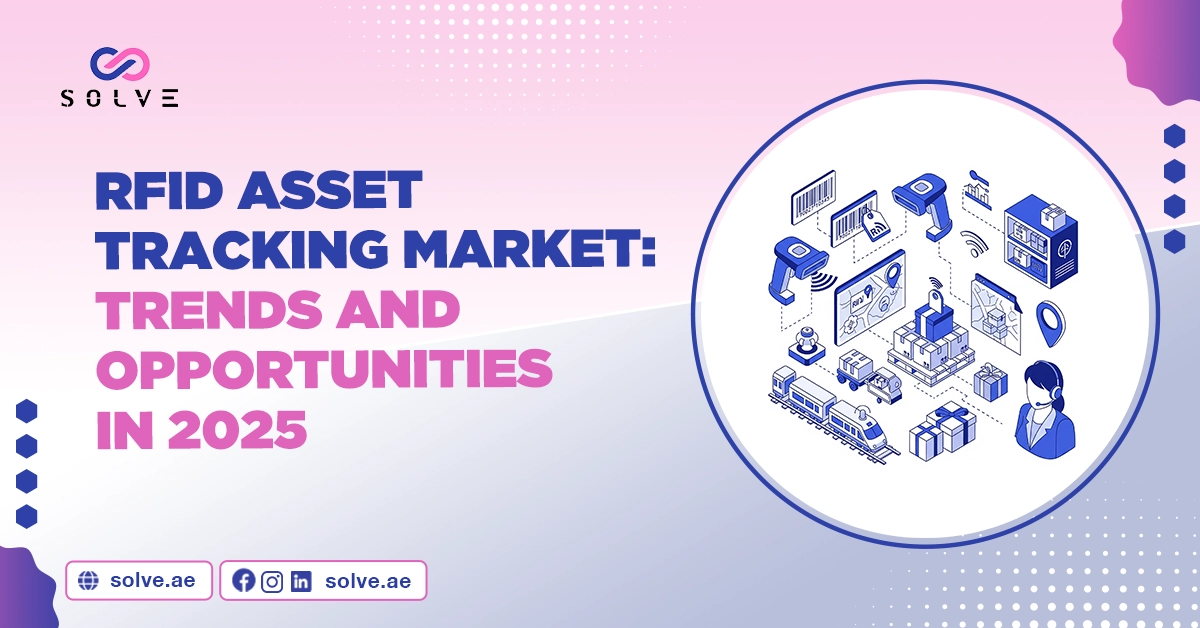- By Vanshika Choudhary
- June 26, 2025
2025 marks yet another watershed moment in asset management due to the rapid uptake of RFID technology across the globe. Gone are the days when RFID was used for mere inventory management; today, it serves as the backbone of each organization’s digital transformation strategies in healthcare, logistics, manufacturing, retail, and many other industries. An aggrandizing market fuels more opportunities for businesses to further efficiency, transparency, and profits. Thoroughgoing market intelligence discusses vigor trends, sector-specific applications, and associated future opportunities for the RFID asset tracking industry in 2025.
Explosive Growth of the Market and Its Changing Dynamics
Forecasts indicate the RFID asset tracking market, which may touch $12.6 billion by 2025, may observe the price doubling by the year 2033. This growth is attributable to higher demand for real-time visibility, loss prevention, and automation of operations. Supply chains need to be optimized, shrinkage reduced, and legislation adhered to—tougher these days—where RFID proposes an answer.
In the transition from very basic passive tags to rather advanced active and hybrid solutions, the technology truly evolved in terms of practical application. An RFID setup of today boasts lengthy read ranges, generous data storage capabilities, and greater physical ruggedness, thus working in environments ranging from extremely cold warehousing spaces to hot, harsh outdoor construction sites. Therefore, organizations are heavily investing in the restructuring of legacy systems and trying to synergize RFID within their larger IoT (Internet of Things) ecosystems.
Interfacing with IoT and Advanced Analytics
In 2025, one of the major trends is the smooth interface of RFID into the IoT platform and advanced analytics. By bringing RFID-tagged assets under the control of cloud-based systems, real-time location, condition, and usage data can be collected and rendered for further analysis by the business. This allows them to have predictive maintenance of stock replenishments and workflow optimization.
By means of RFID and the IoT, logistics provide a sense of final visibility for goods traversing the supply chain. Sensors realize temperature, humidity, and shock while warning the managers of possible concerns well in advance and before an issue becomes expensive. Within manufacturing, RFID-embedded IoT networks track tools, machines, and raw materials to keep downtime away and allow lean production strategies.
Industry-Specific Application and Transforming Benefits
Healthcare
In the healthcare setting, RFID has gone through dramatic changes by enabling real-time inspection of medical devices, medicine, and even patients. Hospitals can locate life-saving devices and track critical supplies for usage, including compliance with safety procedures. RFID hinders unauthorized movement of assets such as infusion pumps and defibrillators to further increase patient care. Interfacing RFID with electronic health records could increase either patient safety or the accuracy of drug administration by eliminating or, at least, decreasing human errors.
Retail
In retail, RFID means game-changing for inventory management, theft prevention, and customer experience. Retailers can achieve an inventory accuracy near perfection toward omnichannel fulfillment, keeping products from going out of stock. Smart fitting rooms with RFID readers allow customers to request other sizes or colors without leaving the room, which is very convenient and increases sales.
Logistics and Supply Chain
The real-time data lets companies optimize routing, reduce delays, and arrive closer to promised times. Greater visibility provided by RFID lets the providers of logistics services add their own value through real-time tracking for the customers and automatic proof-of-delivery. The system also supports regulatory compliance in tracking hazardous materials or food products.
Manufacturing
RFID provides the movement and tracking of tools, parts, and finished goods through the manufacturing processes. This visibility enables just-in-time manufacturing. Any bottlenecks are removed, reducing errors and increasing productivity. RFID is also used for automated quality control, whereby the system ensures that one-and-only-if-the-correct-use-parts are used for each stage of the assembly.
Construction and Emergency Management
RFID tracks tools, equipment, and materials on construction sites to ensure that the right resources are available at the right place and time. This lowers downtime, prevents theft, and improves the project’s timeline. Check out our latest blog post on The Ultimate Checklist for On-Page SEO in 2025
Regional Growth, New Markets
Concrete, with the continued North American and European dominance, Asia Pacific portrays the fastest-growing demand on account of industrialization, urbanization, and digitalization efforts. China, India, and Singapore witness ample growth in smart infrastructure, logistics, and healthcare systems, offering China, India, and Singapore enormous opportunities for RFID solution providers.
In those emerging markets of Latin America, the Middle East, and Africa, the beginnings of the adoption of RFID from agriculture to mining and oil and gas are being made. Unique challenges of harsh environmental conditions and connectivity in these regions are prompting innovations in the hardware design of RFID systems and in network designs.
Technological Advancements and Hybrid Solutions
It can be said that the evolution of RFID technology is fast. Newer generations of passive RFID tags and readers will continue to offer more range, higher data transfer rates, and interference resistance. A hybrid solution that would combine both passive and active RFID or combine RFID with other tracking technologies like GPS and Bluetooth has gained more significance because of its versatility.
BAP tags, for example, lie somewhere between passive and active systems, offering more range without the prohibitive price tags of active tags. Advances in antenna design and energy harvesting are probably making RFID perform well even in harsh environments of metallic warehouses or outdoor construction sites.
Security, Privacy, and Data Management
As systems continue to permeate existence, data security and privacy issues move to center stage for consideration. Nowadays, companies have encryption, secure authentication, and stringent access control built into their enterprise-grade RFID solutions.
Data management comes next on these considerations. The huge amount of data coming out of RFID systems demands scalable storage, efficient processing, and intelligent analytics. Recent trends point towards cloud-based platforms and computing for data flow control, latency reduction, and real-time decision-making.
Challenges and Barriers to Adoption
Small and medium-sized enterprises bear higher levels of initial cost when purchasing hardware and software, along with integration charges. In settings laden with metal or liquid, for example, the interference can pose a problem in terms of reliability. Then, with compatibility with legacy ancient systems and training of staff, we have more barriers. Businesses are developing cheaper and modular devices to help ease barriers, bundling them with support and maintenance services.
Regulatory Landscape and Compliance
Governments and industry bodies establish RFID-related regulations to ensure safety and ethical standards. In healthcare, the provider must adhere to data protection laws, such as HIPAA. RFID supports the traceability mandates laid down by regulators in logistics and food safety. Keeping abreast of the changing regulatory environment and ensuring compliance is a major challenge for and, indeed, an opportunity for solution providers.
Conclusion: RFID in the Future of Asset Management
Lastly, RFID Asset Tracking strolling through 2025 and beyond, RFID asset tracking hangs at the crux of digitization and operational excellence. With its potential to offer real-time visibility, automation, and actionable insights, Contact us as it is redefining the landscape of industries and opening new trails for growth. Seeing the latest buzz, confronting roadblocks, and utilizing RFID to its fullest, a business sets itself on the pathway to success in an already interconnected and funding-heavy world.




